
Thank you Mithilesh. Cambodia is surely a place to travel with buddies and that's what I have done many times.
2,706 views
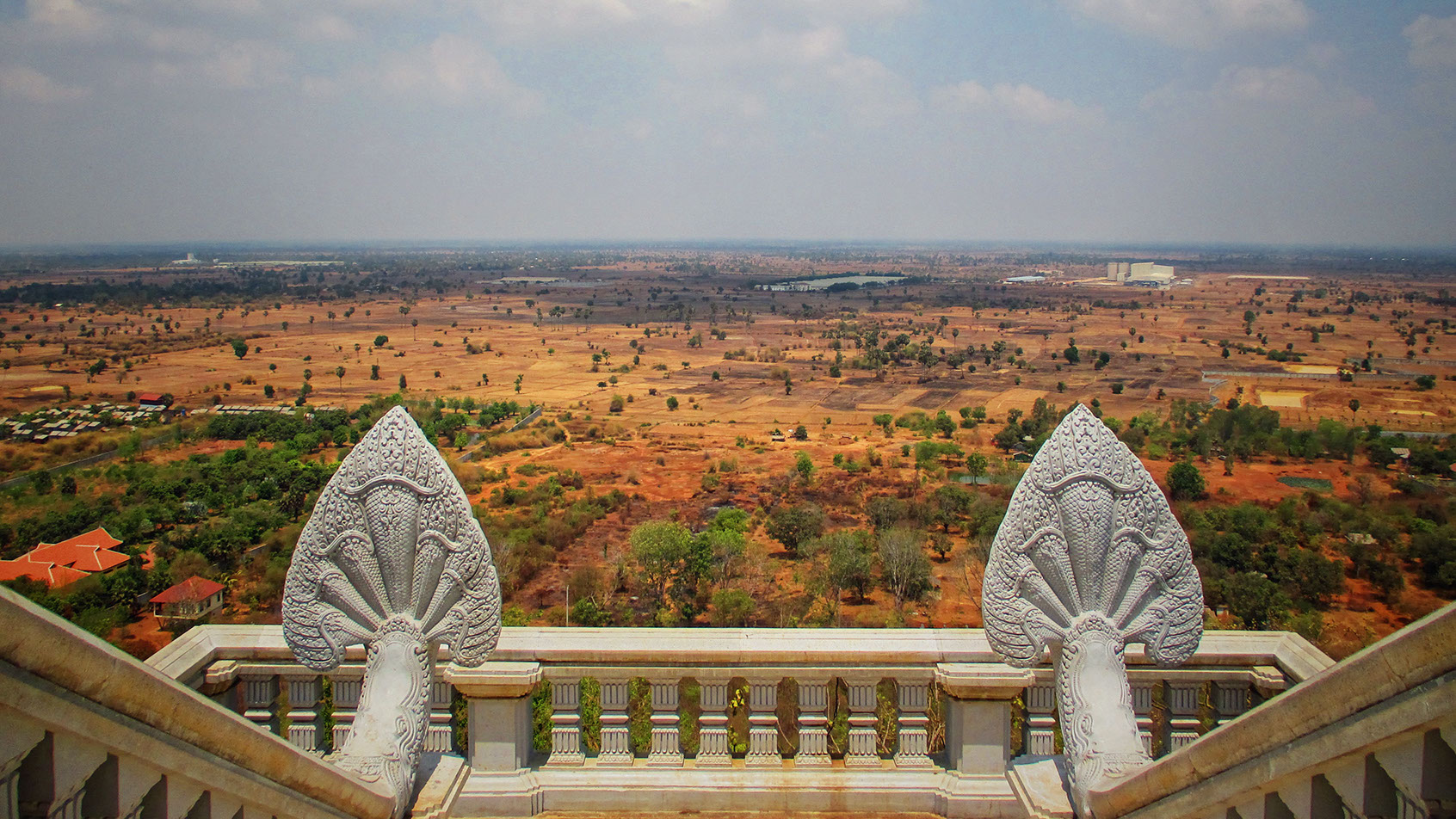
Cambodia is a treasure trove of culture and history with well known UNESCO World Heritage Sites. While Angkor Wat is famous and on most visitors’ MUST VISIT list, most people are oblivious to Oudong. Curious, right? I was too, when I first heard about this incredible ancient city. Always seeking unique experiences, I enquired with my clients about offbeat places in Cambodia that I could explore and that’s when I heard about Oudong. While researching about the place, I realised that there was not much information about this historical site, which prompted me and my colleague to make the trip.
Living in Cambodia, we had access to a car and a driver which made traveling convenient. A visit to Oudong is a perfect day trip. It is situated about 40 kilometers to the north-west side of Phnom Penh (google maps). We began our hour-long drive early in the morning to beat the scorching heat of Cambodia. While a taxi is the easiest and hassle-free way to travel to Oudong from Phnom Penh, it is slightly expensive. However, it's also possible to reach there by tuk tuk, although the journey takes 2 hours as the roads can be quite dusty. If you do choose to take a tuk tuk, be sure to pack plenty of water and dust cover masks for the journey. At around $50 for a round-trip, it is well worth it. You can also book a private guided tour to Oudong.
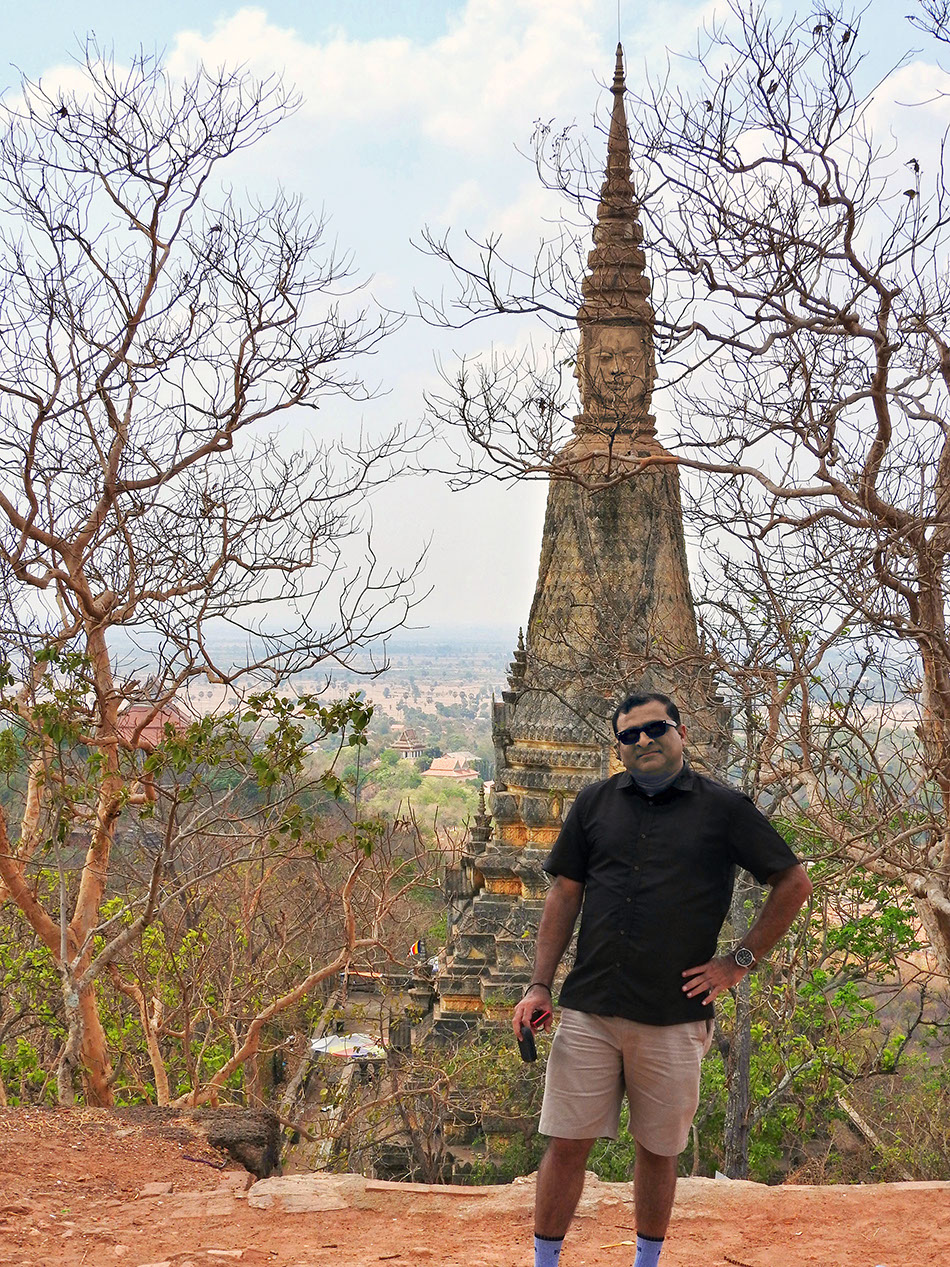
A viewing platform enroute to the top of the Oudong Mountain with Mukh Proum in the background was perfect for a photo
It is important to note that Oudong does not have decent hotel accommodations. It is recommended that you stay in Phnom Penh and visit this city.
Checkout the best hotel deals in Phnom Penh.
Located in the Kampong Speu Province of Cambodia, the Oudong mountain range has much historic significance. For centuries together, the mountain range has been a significant location for religious events and spiritual pursuits. In addition to its rich history and folklore, Oudong is a fascinating place to discover.
In the 15th century, historical sources first mention Oudong. During that time, it was called the "Phnom Oudong" (Phnom in Khmer means Mountain) and it was considered a sacred place by the locals. It was selected as a site for the construction of a number of spectacular temples and shrines in the 16th century. On reaching Oudong, history comes alive. The ancient ruins, restored stupas and the surroundings exude a grandeur and opulence that once existed in this iconic place. The city was founded in 1601 by King Srei Soriyopear. From 1618 to 1863, also known as the post-Angkorian period, Oudong was called 'Oudong Meanchey.' This was the capital for the royalty deposed from Lovek's former capital. The derivation of "Oudong" is from the Sanskrit word "Uttunga", which means "Supreme" or "Victorious".
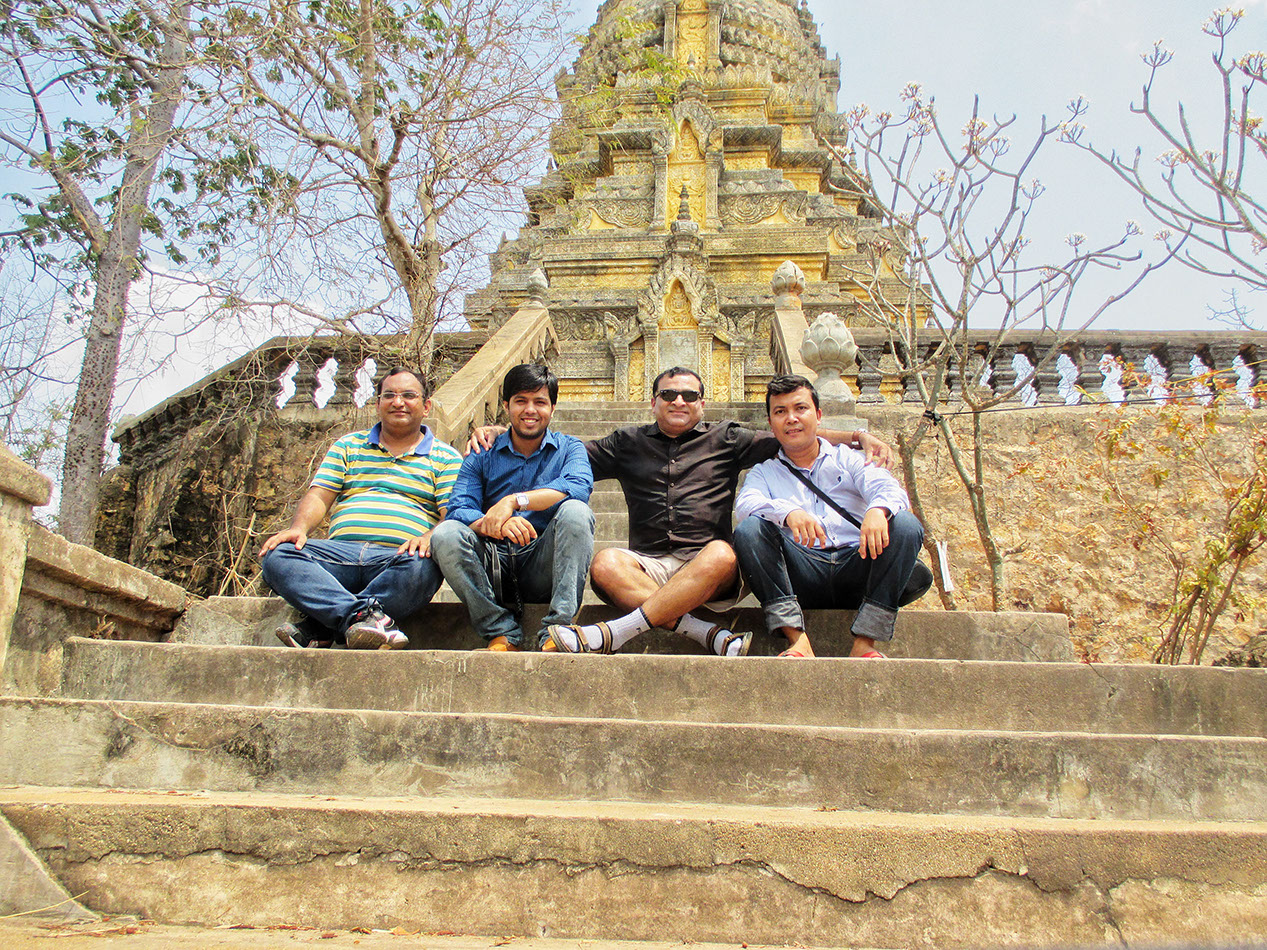
My colleagues and myself with our hospitable driver Kunti
Oudong is also pronounced as Udong, which was Cambodia's former royal capital from 1618 to 1866. During this period, Oudong had become an essential center for Khmer politics and culture, and there were also many royal palaces and temples built in this place. During the late 19th century, King Norodom shifted the capital of Cambodia from Oudong to Phnom Penh. With this, the decline of Oudong had begun. In the present day, Oudong is a very small town and has a population of about 8,000 people.
The picturesque surroundings and rustic ambience was a refreshing break from the hustle and bustle of the cities. We were welcomed by a group of local kids who acted as "tour guides''. We were warned about this and politely declined their "services" but they persistently followed us hoping to make an impression and be compensated. At the base of the mountain near the path, is a memorial buried with bones of hundreds of bodies exhumed from one of the Khmer Rouge killing fields.
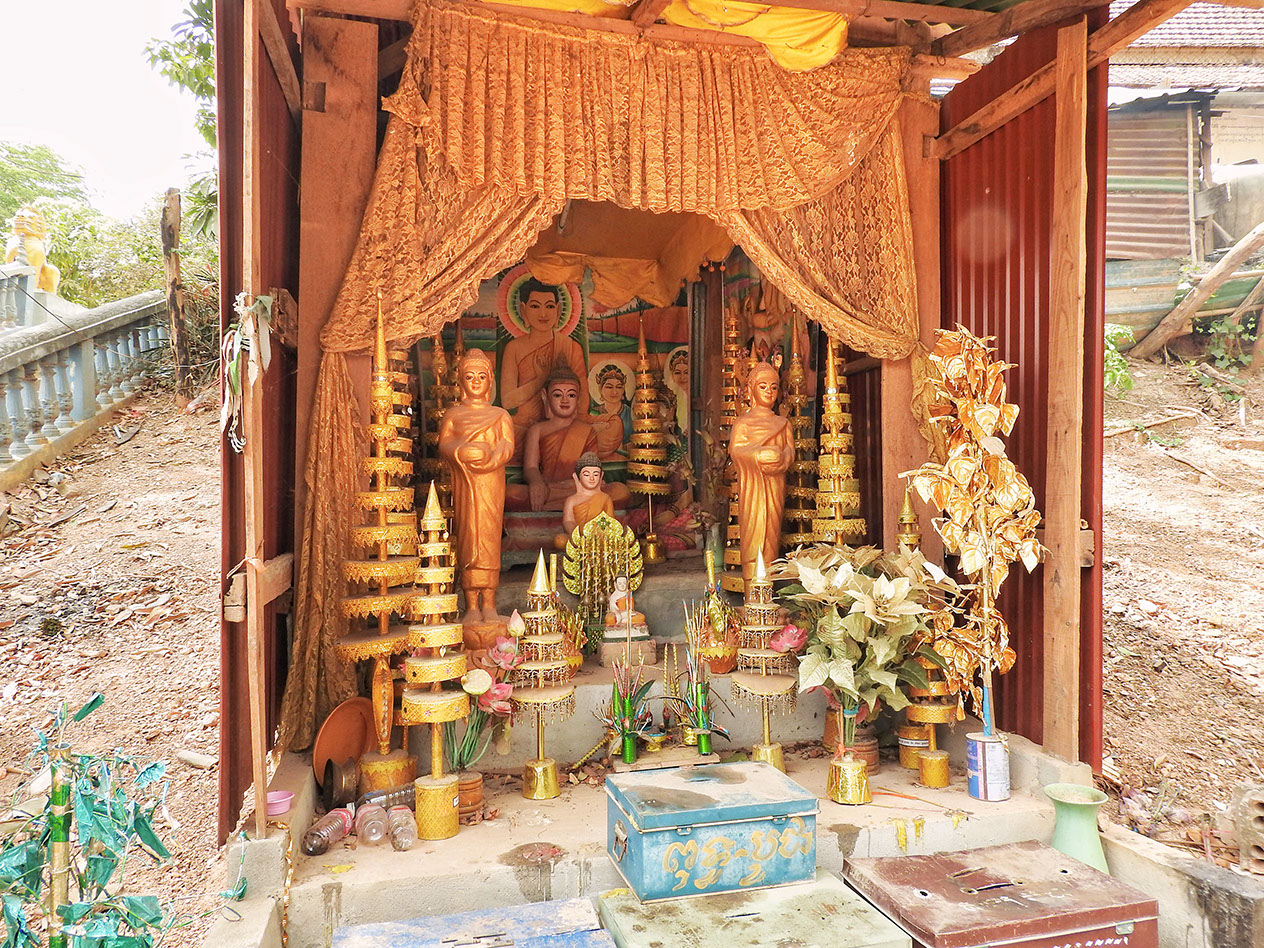
The memorial at the base of the Oudong Mountain that signifies the Cambodian genocide during the Khmer Rouge
The Khmer Rouge in 1974, seized Oudong during the Cambodian Civil War, and they began a campaign of destruction there in 1977, leveling and altering the temples and monuments that had been there for centuries together. In the end, the city was left in sheer ruins; almost erasing its magnificent history. It is a testament to the bloody and horrific past. Stairs to the left, led to a huge, shattered statue of Buddha where the only part intact was the feet. Following the path up the mountain to the right, we climbed a steep flight of stairs to reach a large structure rising on the left. Inside sits another ravaged statue of Buddha with only his right arm and shoulder intact. The statue was surrounded by remnants of huge pillars testifying to the destruction inflicted by aerial bombings and shelling that shook Oudong from 1970 onwards. We paid our respects to the dead at the memorial and then started ascending the 509 steps to reach the top. This climb from the north side is not difficult, and there is sufficient shade from the trees that prevents it from getting too hot.
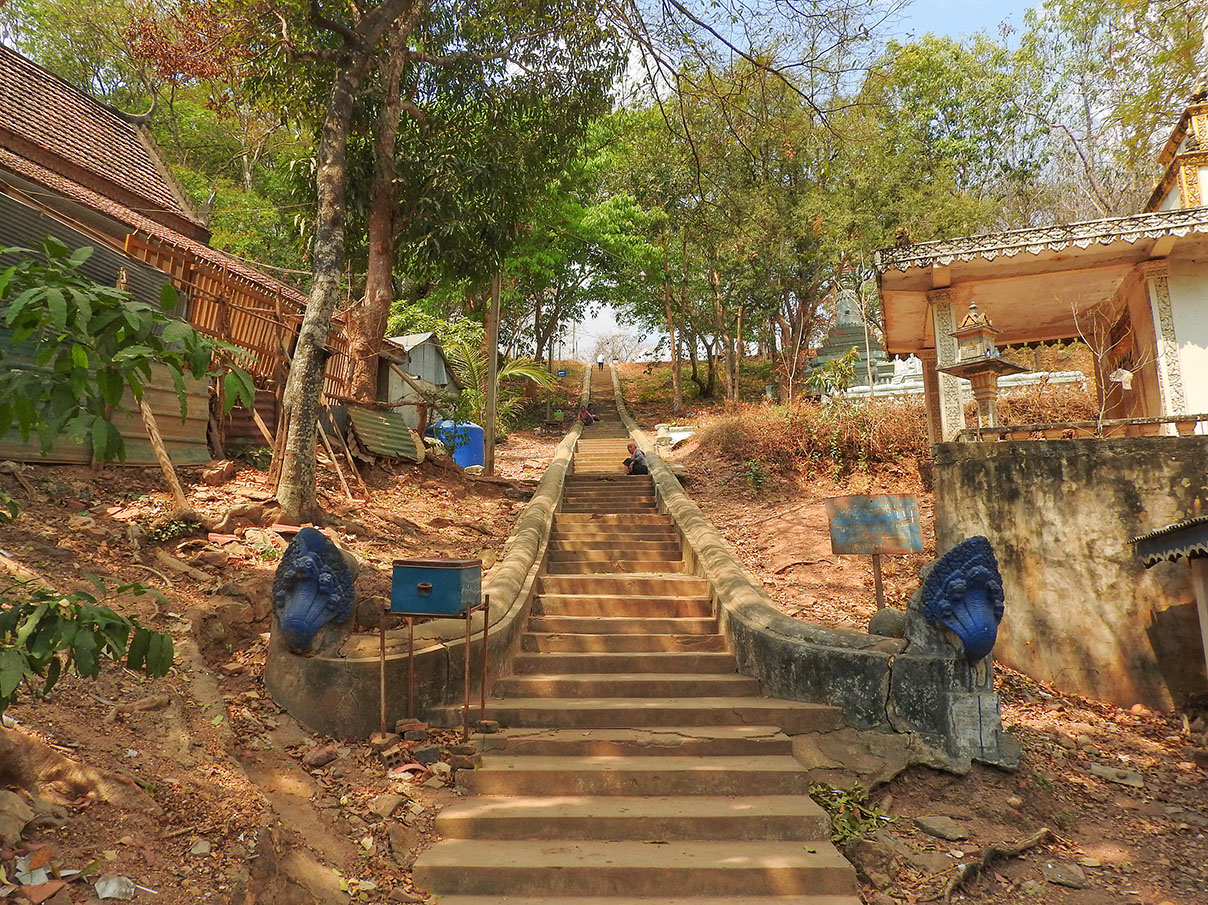
The 509 steps leading to the top of the mountain lined with small temples on either side
Oudong perched on top of the mountain consists of a cluster of stupas and temples. The three main stupas are Damrei Sam Poan, Ang Duong, and Mukh Proum. The Oudong stupas are also known as Chedis in Khmer. They constitute a large cemetery of the past kings of Cambodia. It was chosen as the funerary site for Cambodian kings because of its sacred and scenic location.
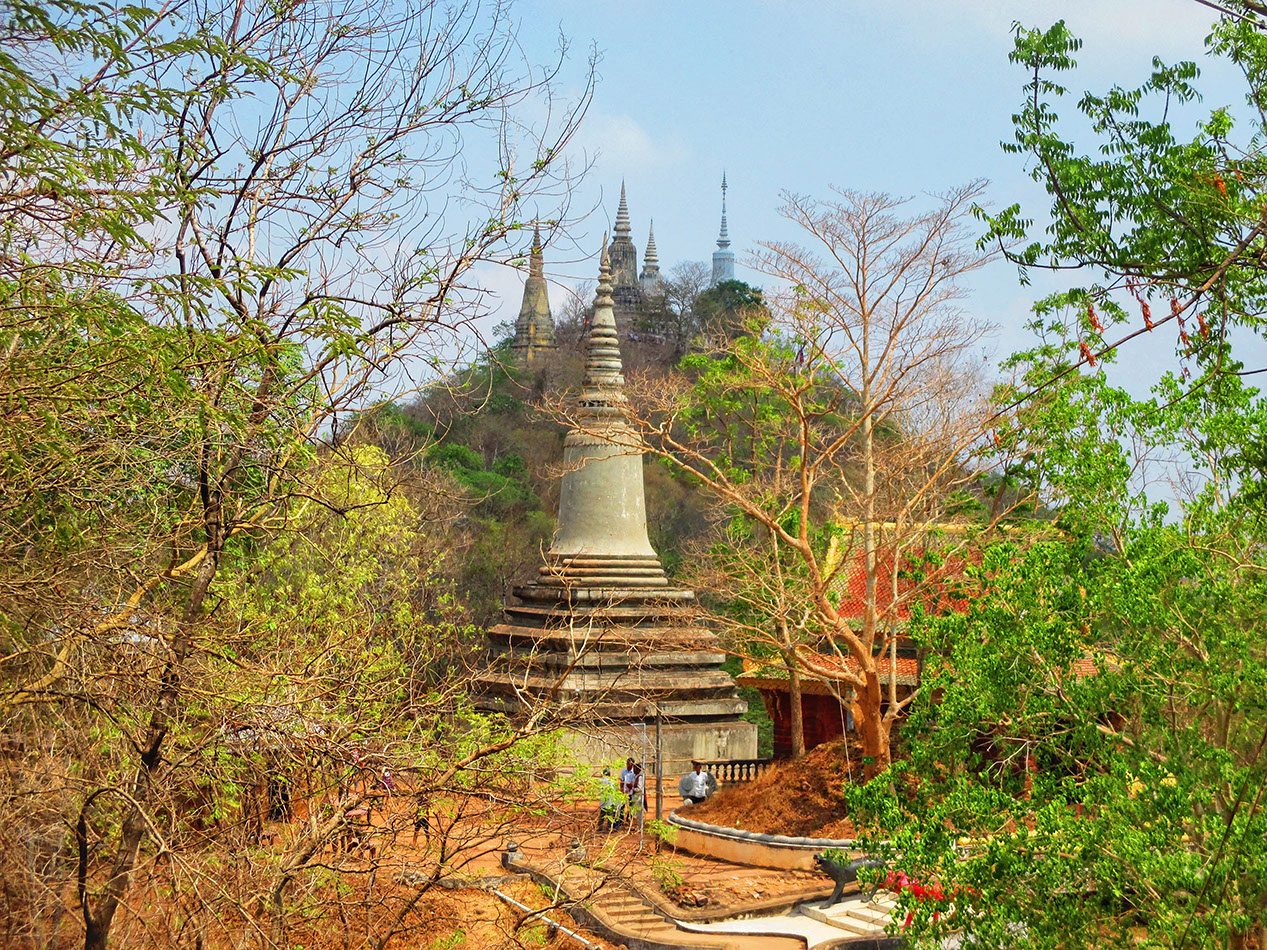
A beautiful landscape view of the stupas as seen from the top of the Oudong Mountain
The smaller temples include Wat Xieng Thong, Wat Ounalom and Wat Moha Montrey. These temples were all built between the 16th and 18th centuries. Together, they provide a unique glimpse into Cambodia's religious past.
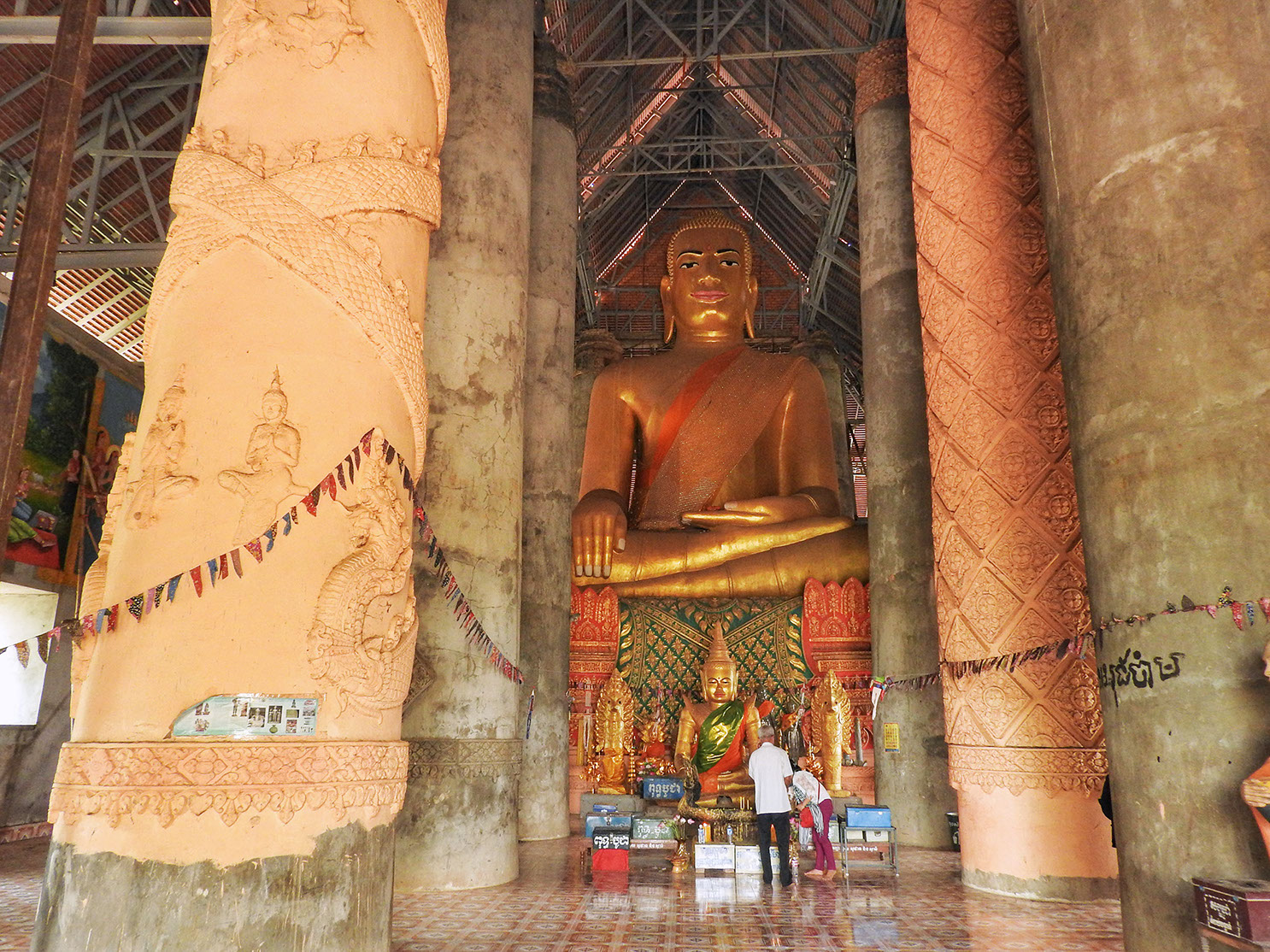
An ornately decorated enormous Buddha statue in one of the temples atop the Oudong Mountain
Most ancient places are associated with interesting folklore and Oudong is no different. According to Cambodian folklore, the "Naga"is a serpent with multiple heads that guards Buddha. Known to be very powerful, they are often portrayed as large and daunting creatures. However, they can also be very protective and generous. According to legend, the Naga originated in Oudong. The city is said to have been constructed in the form of a Naga with its curvy streets and serpentine waterways. Each year, large multitudes of pilgrims journey to Oudong to pay their respect to the Naga and pray for their protection.
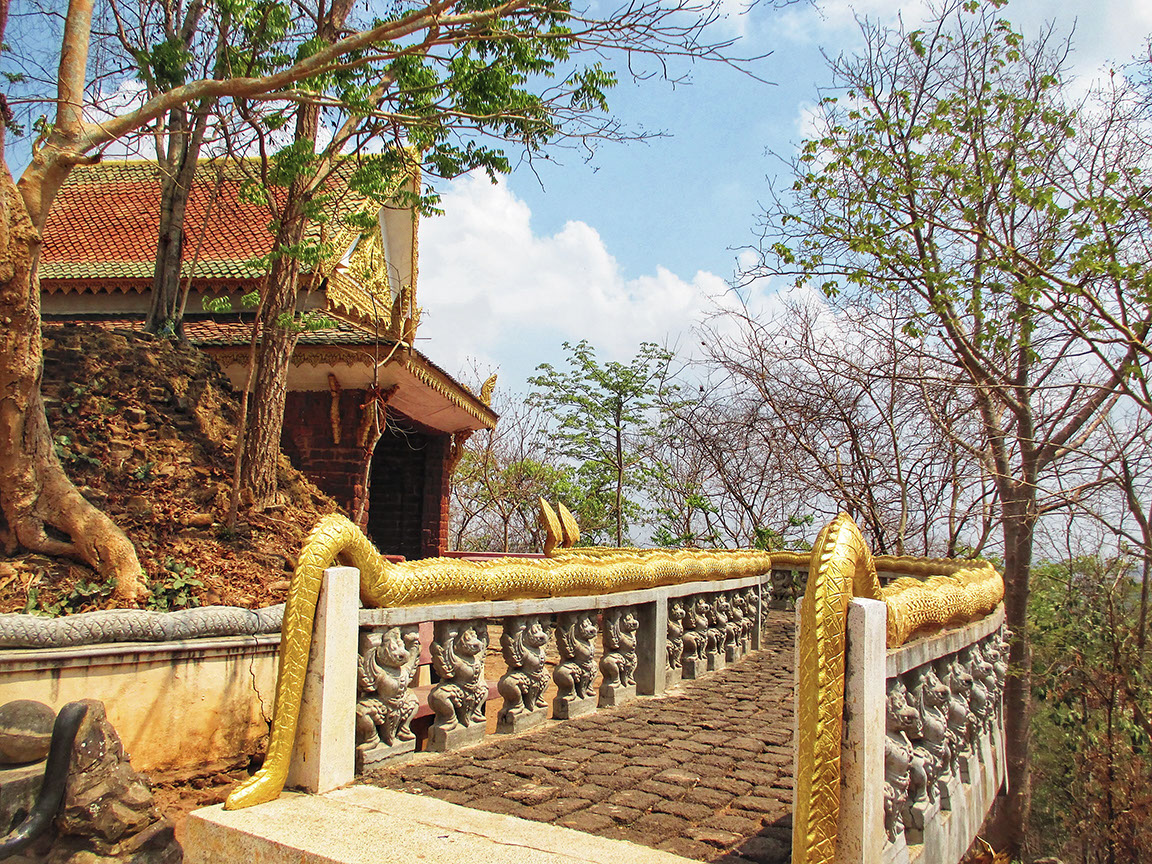
The gold 'Naga' positioned outside the temple protecting Buddha
The first stupa is named Damrei Sam Poan. This north western stupa was built by King Chey Chettha II (1618-26) to bury his predecessor who founded Oudong. The principal stupa, sits on a three-tiered platform raised high above the level of the surrounding forest.
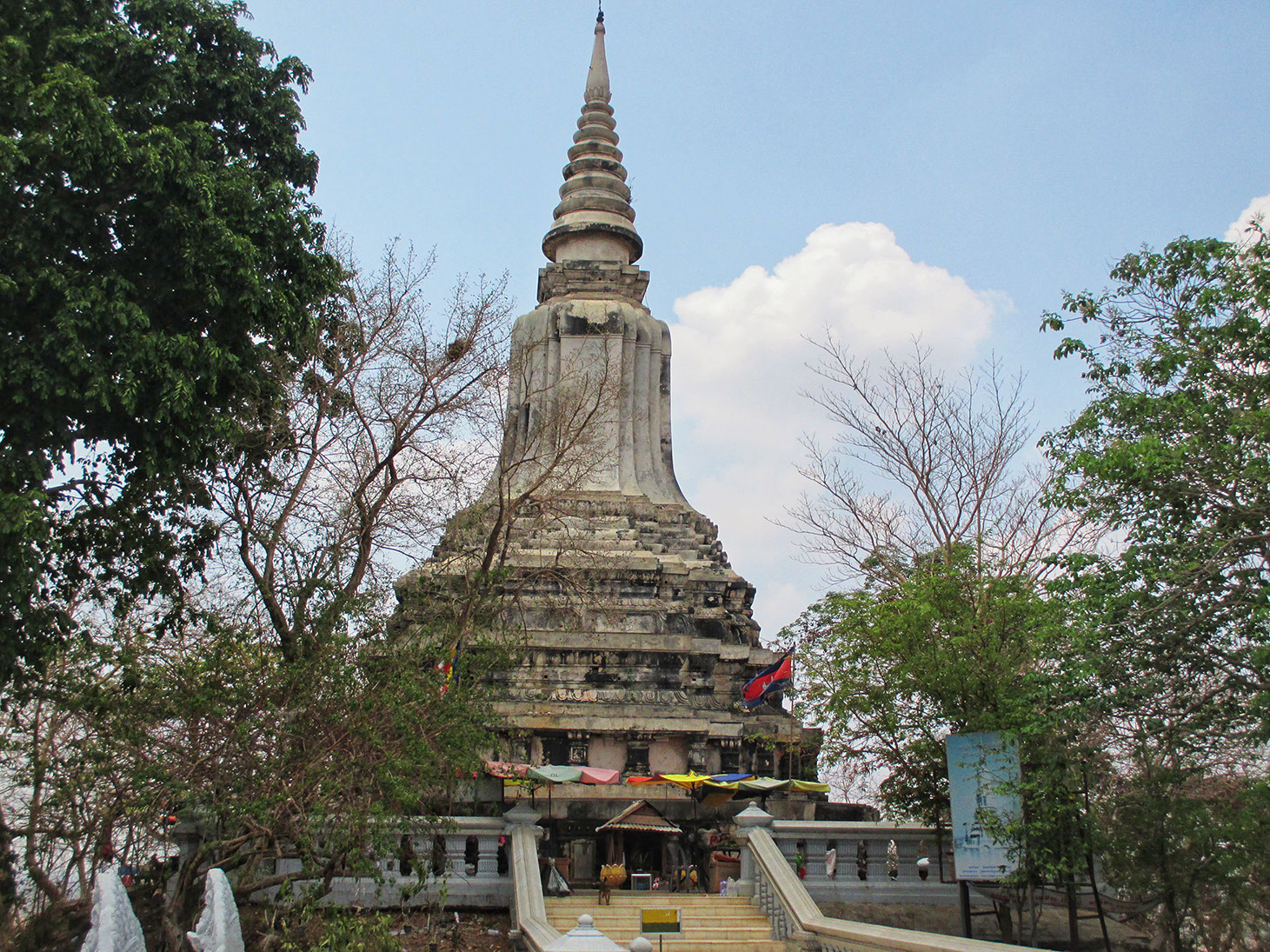
Damrei Sam Poan Stupa is the principal stupa which is a royal burial place
The second stupa is named Ang Duong, after the father of King Norodom. King Norodom built the stupa in 1891 to house the ashes of King Ang Duong (1845-59). Colorful tiles decorate the stupa. Every year, on the anniversary of his death, a festival is held at the stupa during which food and flowers are offered up to his spirit. Locals believe that the spirit of King Ang Duong still inhabits the stupa and that he continues to protect and watch over them.
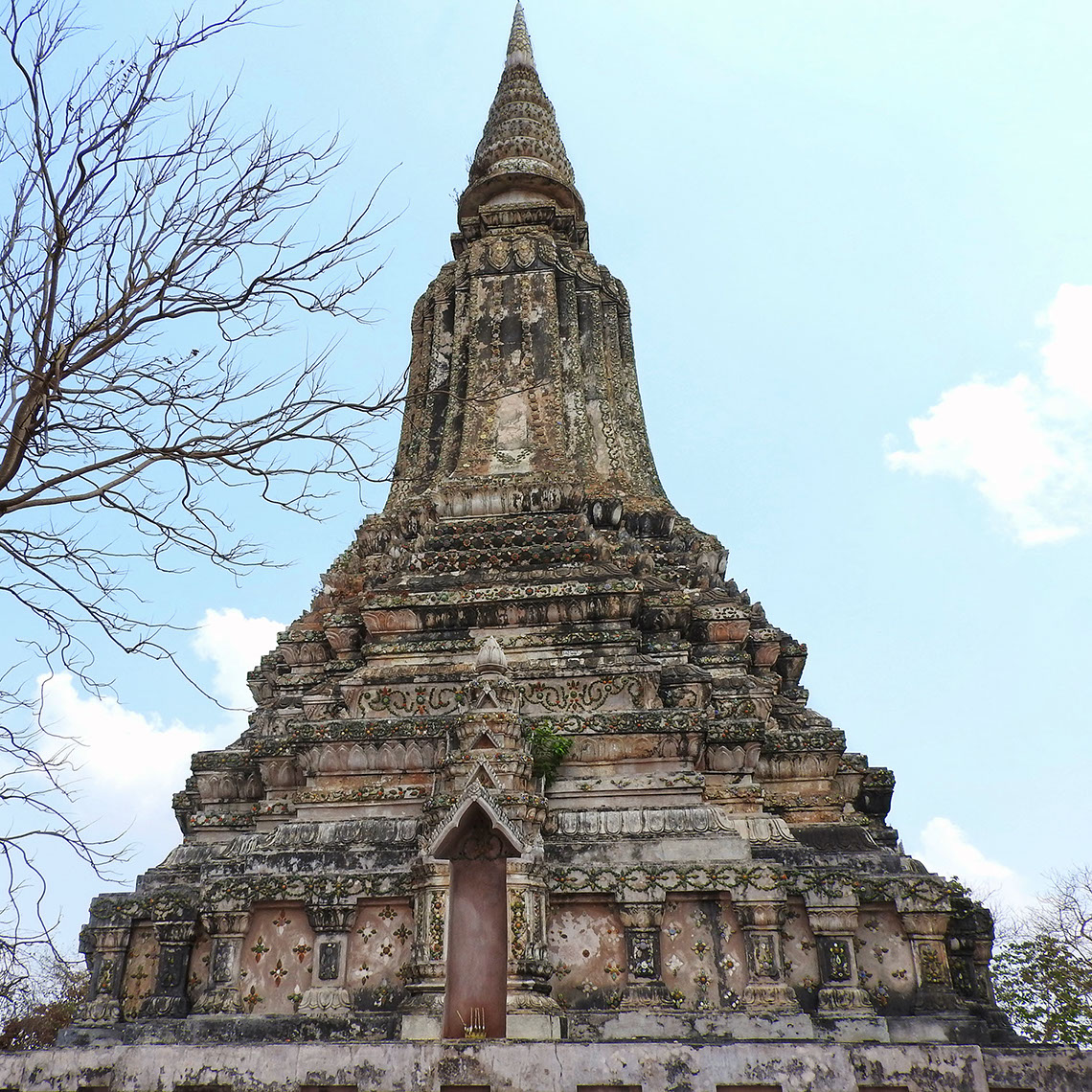
Ang Duong Stupa that houses the ashes of King Ang Duong
The third stupa is named Mukh Proum and is located on the south eastern side of the three stupas. It is the funeral stupa of King Monivong, who ruled from 1927-1941 and features four faces looking outwards towards the four cardinal directions. "Mukh" means face in Khmer. It is similar to Bayon Temple in Angkor Wat complex of Siem Reap. The lower portion of Mukh Proum is adorned with Garudas (a mythical creature in Hindu and Buddhist mythology), elephants, and floral ornamentation. Upon King Monivong's death, his ashes were interred within the stupa.
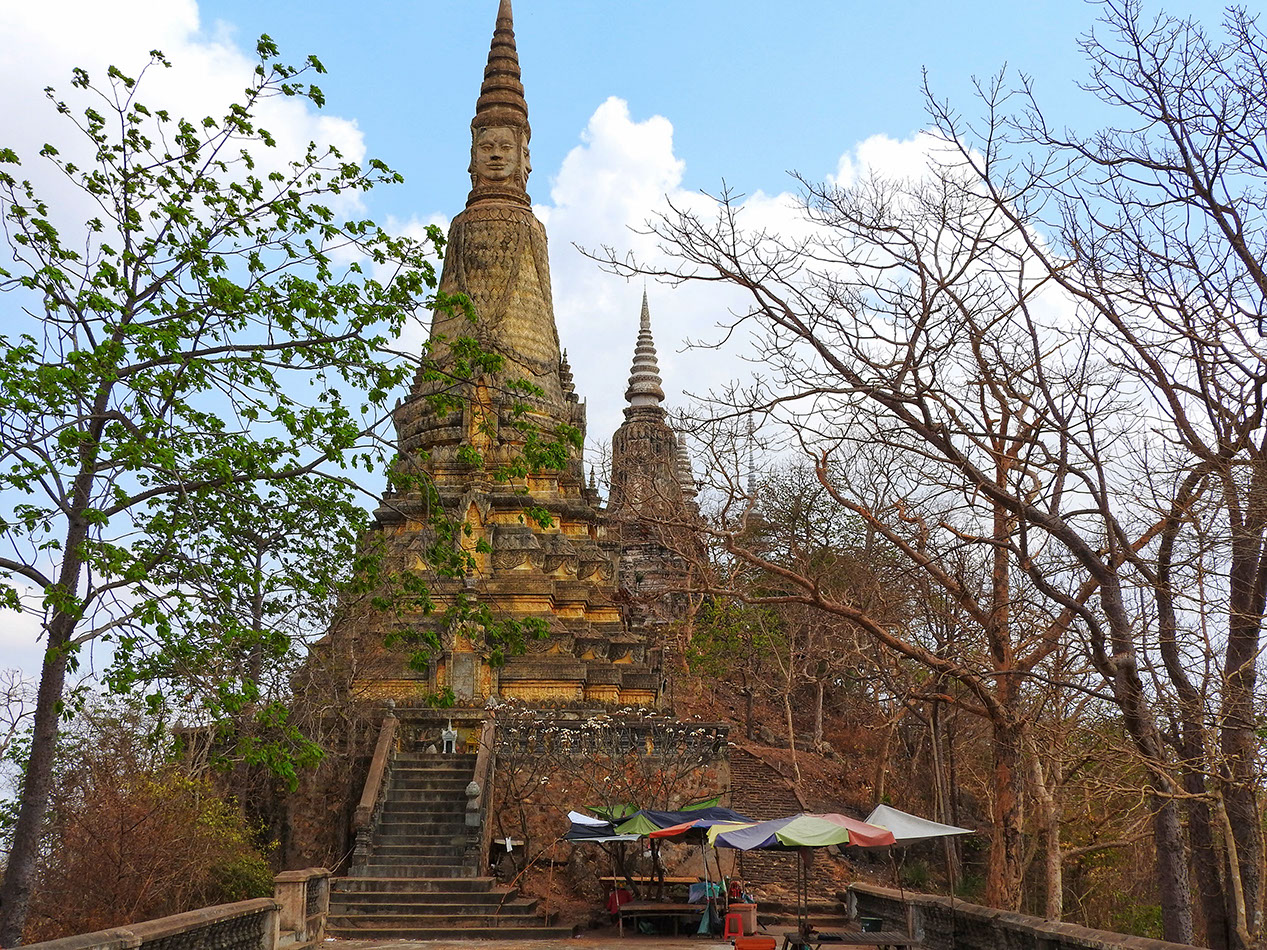
Mukh Proum Stupa, resting place of King Monivong
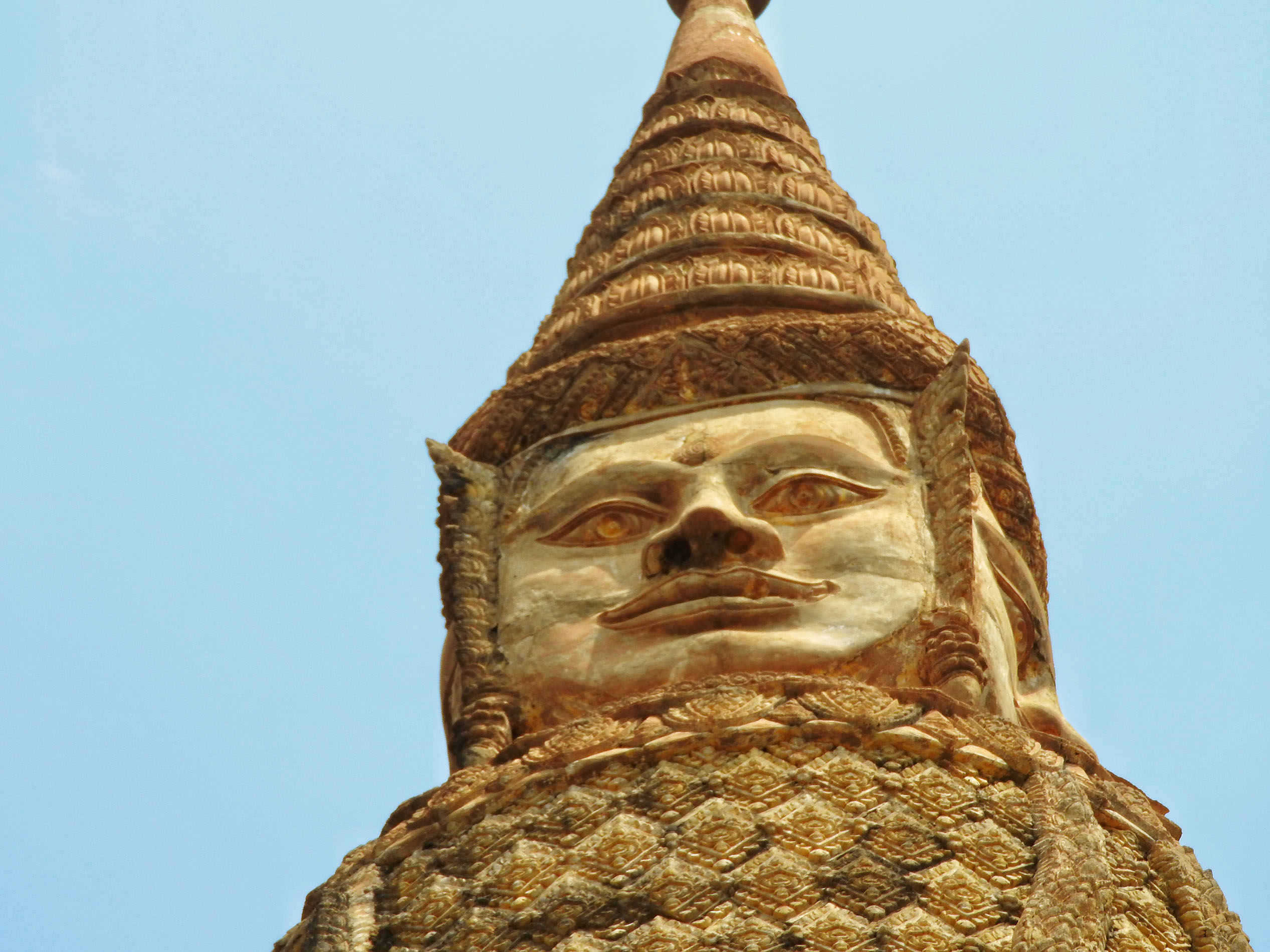
One of the four faces of Buddha in Mukh Proum
Along the route we saw plenty of small temples with historic significance. Walking along, we took a peek into the temple structures even though they were a little dilapidated. There are three small Viharas behind Mukh Proum, the first one, Vihear Prak Neak, in a ruined condition, has a Muchalinda Buddha, the seated enlightened one seated guarded by the Naga king Muchalinda, "prakneak" means "protected by Naga". The second Vihara shelters a seated Buddha. The third one is Vihear Preah Keo, named after the statue it contains, "PreahKo" means "sacred bull"; the original bull statue was looted by Thai invaders and now holds a replica.
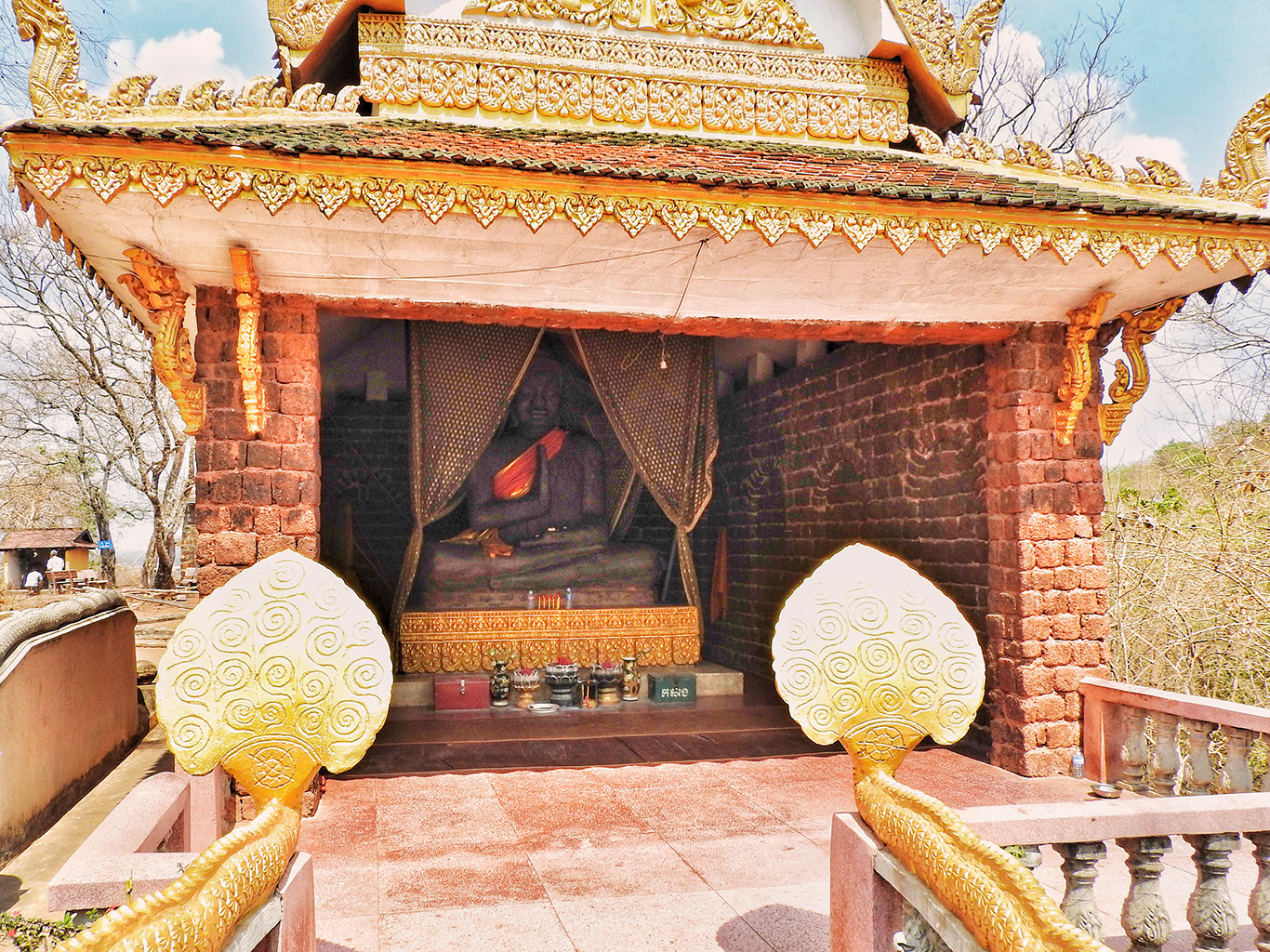
The Buddha statue in the shrine protected by the 'Nagas'
Established in the 11th century, Oudong was the primary residence of the entire kingdom up until the late 18th century. At its zenith, Oudong, being the capital city, was home to more than 100,000 people. However, during the early 1800's, it was abandoned as the capital was shifted to Phnom Penh. Today, although deserted, Oudong remains a beautiful site visited by tourists and pilgrims. These temples are often visited by the locals who come to pray and pay their respects to the dead. We saw flowers, offerings and candles lit up in these temples by the locals. The air was filled with a strong aroma of incense. Despite its present state of deterioration, Oudong holds an essential place in Cambodian history.
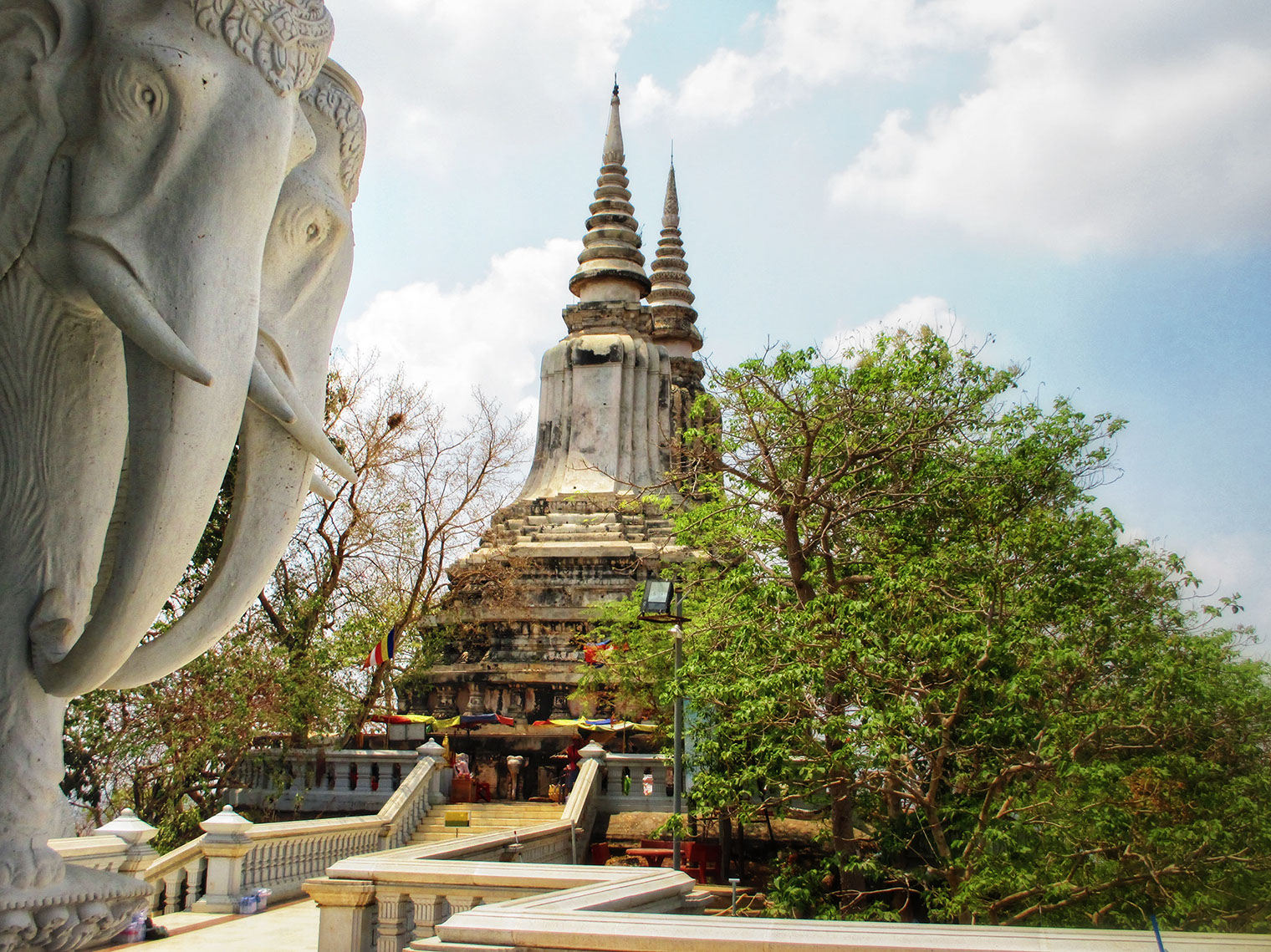
The bridge that connects the ancient stupas to the new structures
While walking further down south, we spotted the well-known Arthaross Temple. The original temple was completely destroyed during the Khmer Rouge and was entirely reconstructed. It was also called the "Temple of Eighteen Points" simply because the temple's structure consisted of 18 points or corners. The temple also held the remains of the gigantic Buddha statue which was destroyed by the Khmer Rouge. The Buddha here faces north instead of the traditional east which has a fascinating folklore weaved around this unusual placement.
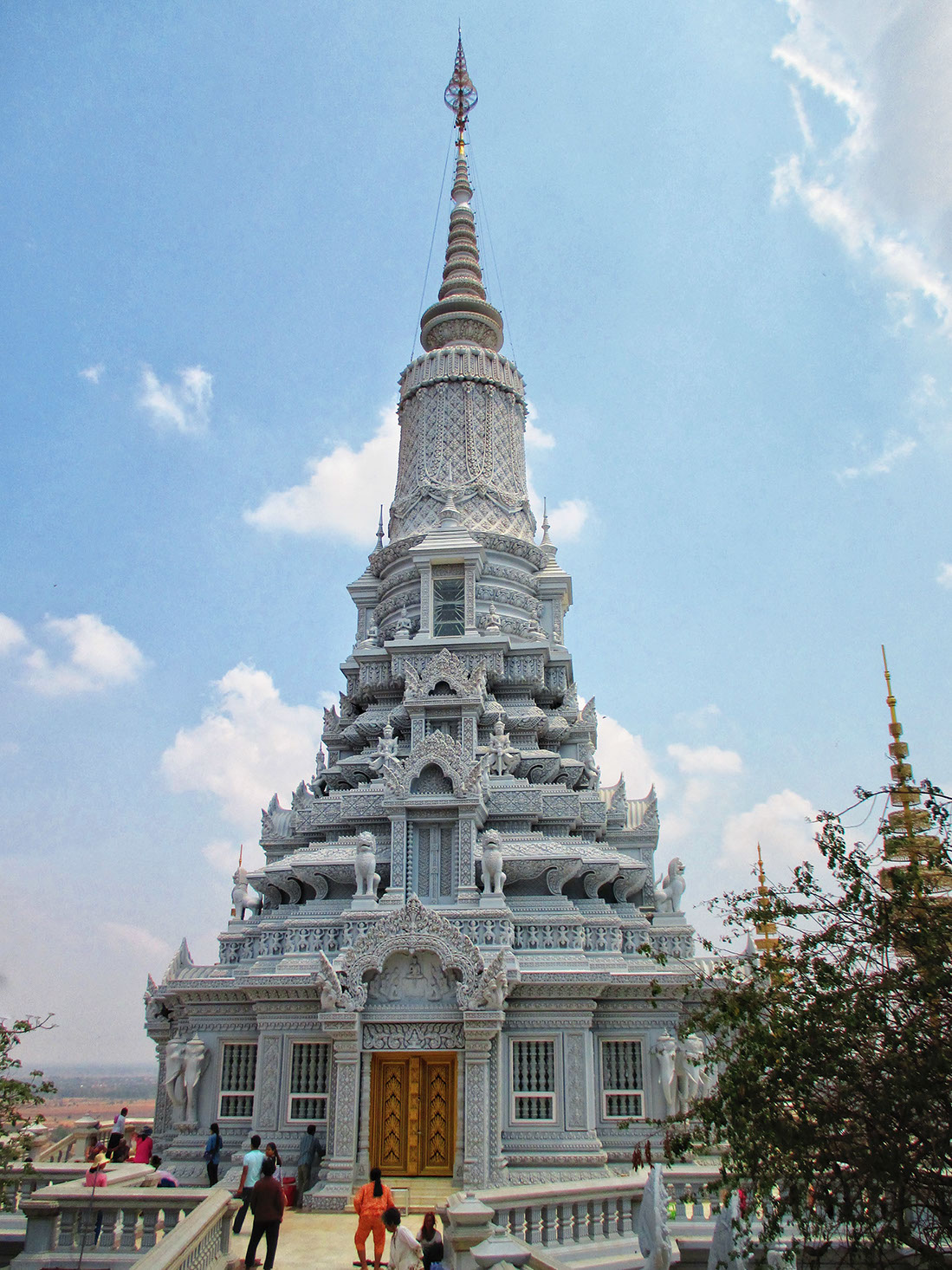
The view of the Arthaross Temple is stunning from the bridge
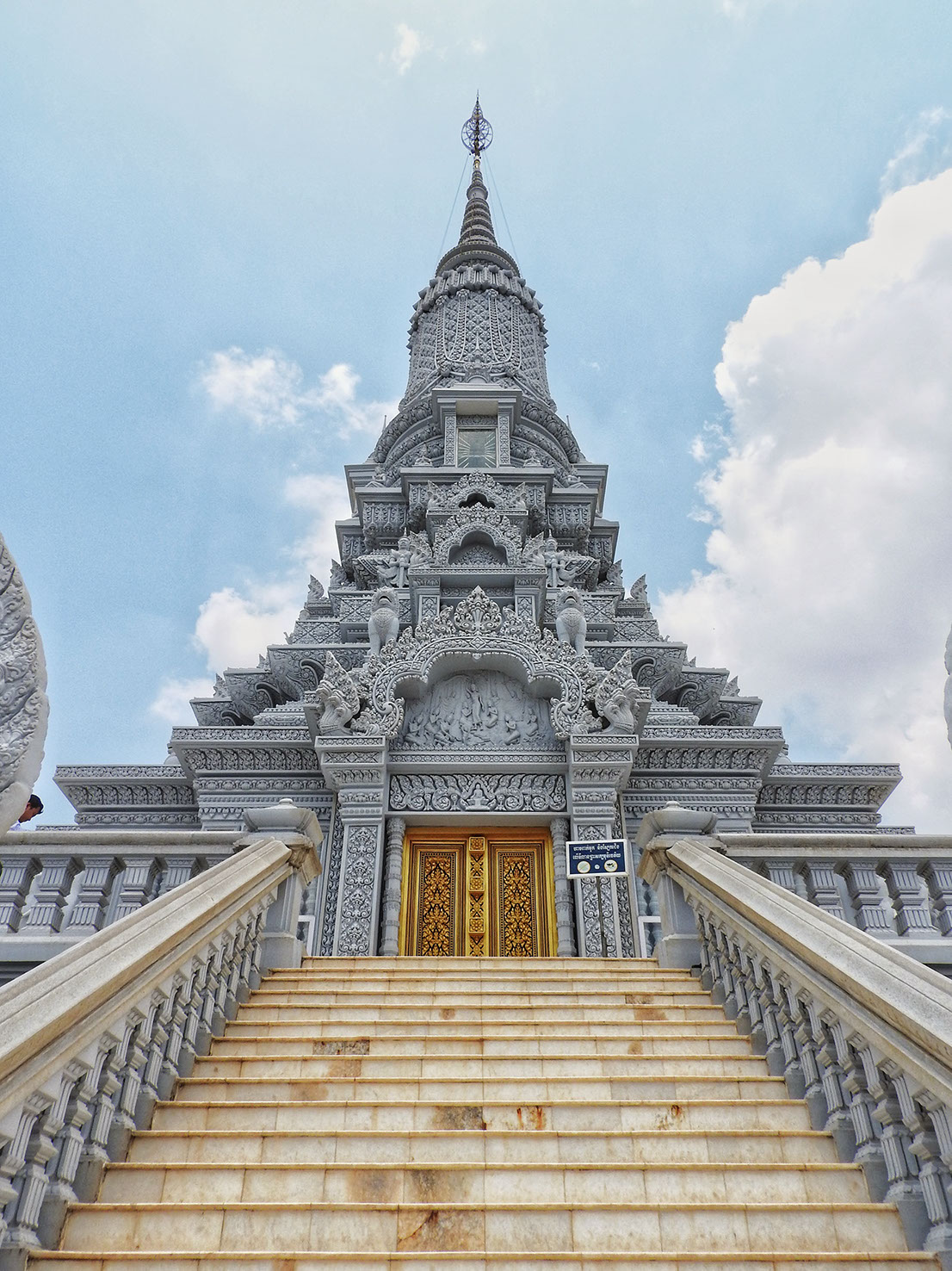
A close up of the Arthaross Temple showcasing the modern architecture and design is captivating
Legend has it that all of Cambodia's treasures were kept safe in a vast cavern beneath the Arthaross Temple. When a Chinese emperor dispatched envoys all across Asia to evaluate potential dangers and threats, they were taken aback by Oudong's wealth. They predicted that the Khmer group would take over the world as soon as a giant Naga serpent emerged from Oudong's cavern. The Chinese became concerned and requested the Khmers to build a temple on top of the cavern, with a Buddha facing the North, towards China. This was done in order to safeguard the country from invasion. This is the reason why the Khmers constructed the temple with the north-facing gigantic Buddha statue.
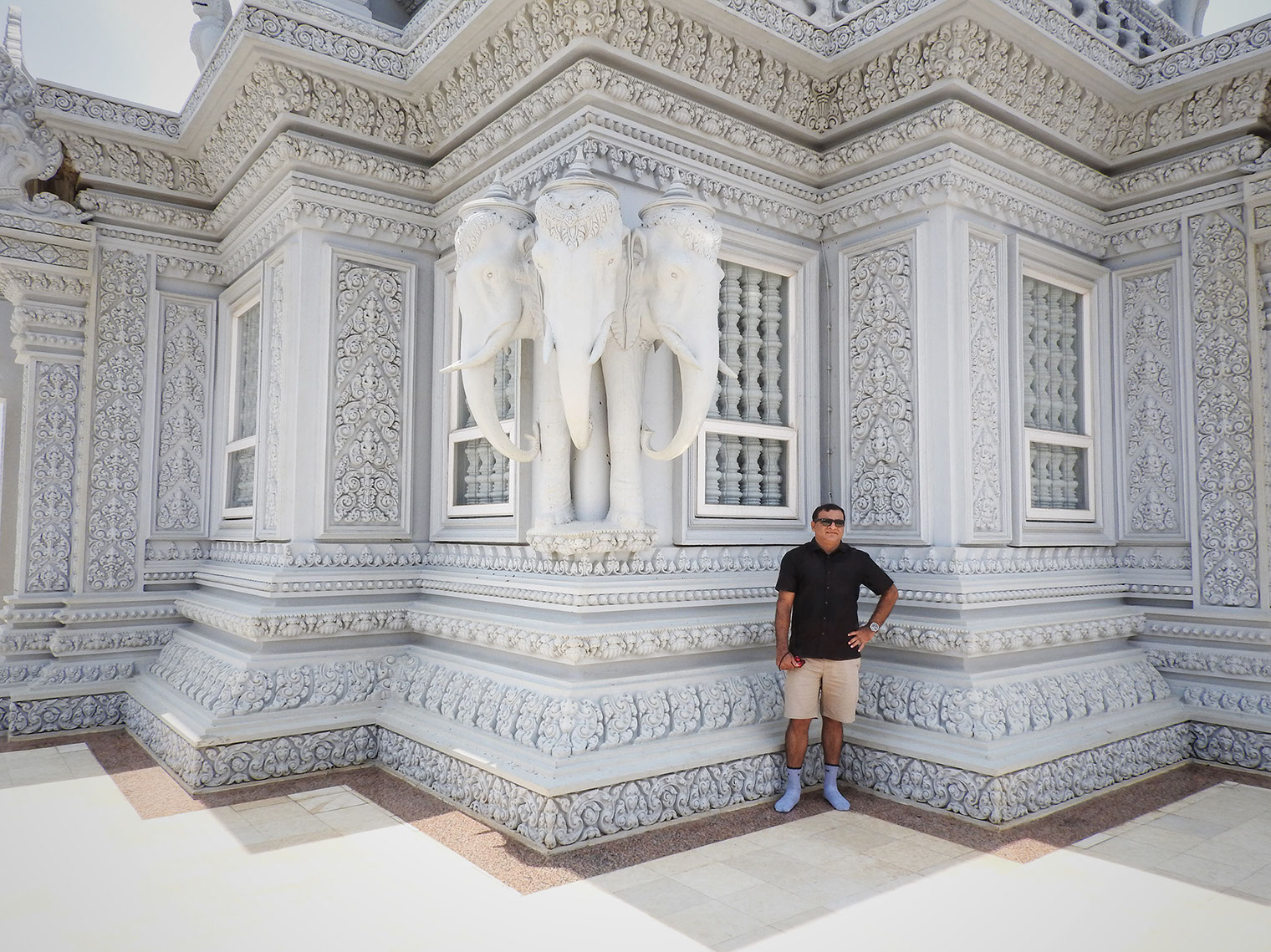
The intricately designed new temple structures are as grand as the ancient temples
Descending down the Oudong Mountain, we came across a bridge. Walking over to the other side, we saw the Preah Shakyamuni Chedi which is a stunning white stupa, a Buddhist temple which was completed in 2002. The main shrine of the temple contains the remains of Preah Shakyamuni, the historical Buddha as well as thousands of Buddha statues. The temple complex also includes a number of statues and paintings, as well as a library and a conference center. The architecture boasts of large carvings of elephants and ornate decoration. We were mesmerized by the contrast of the ancient structures as compared to the recent buildings.
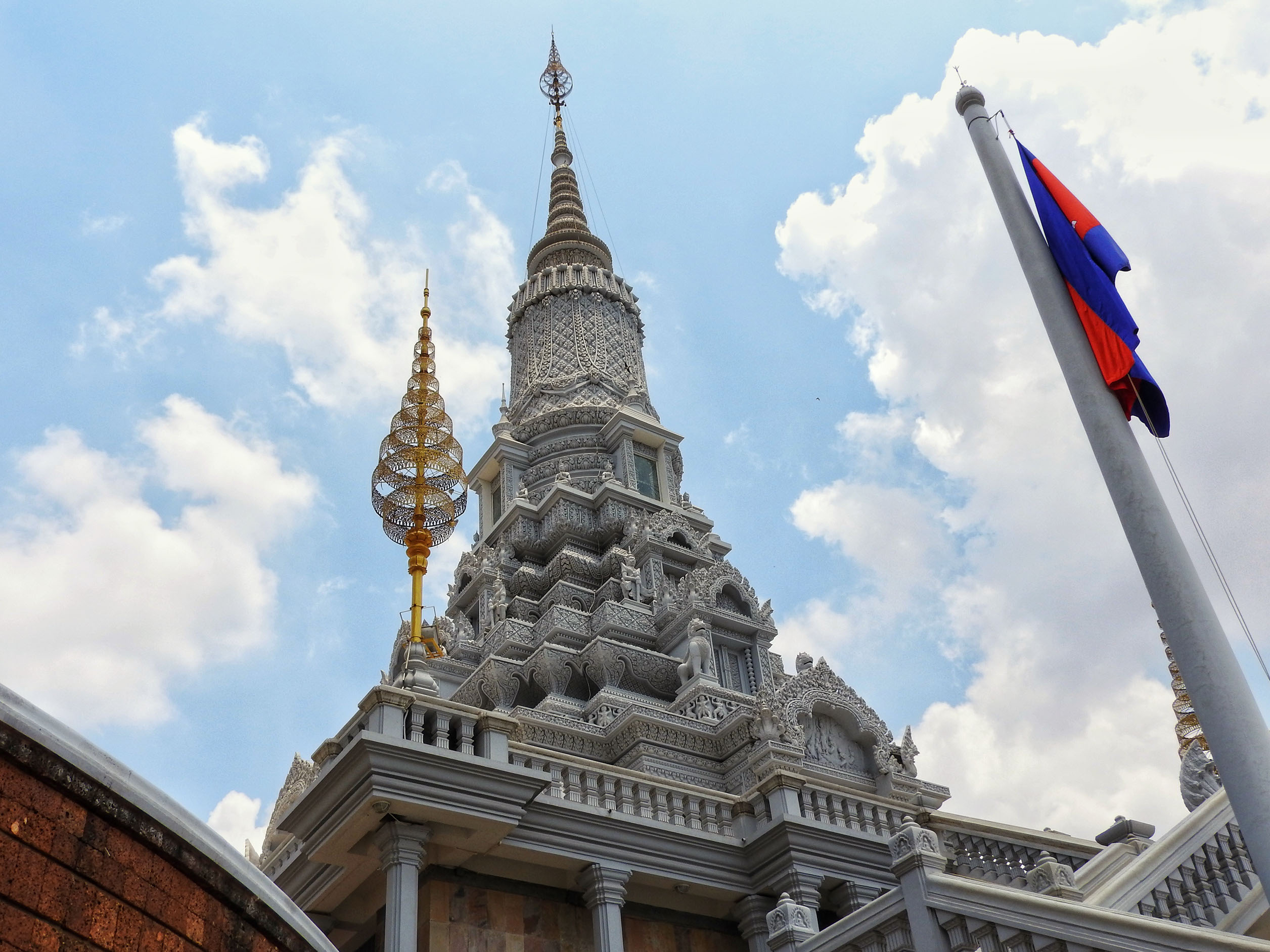
Incredible architecture of Preah Shakyamuni Chedi is mesmerizing
On our walk up and down the Oudong Mountain, we stopped at regular intervals to enjoy the scenic surroundings admiring the countryside adorned with verdant rice paddies spread out beneath dotted with sugarcane plantations and small farmsteads. There are several viewing platforms along the way offering incredibly soothing views of the landscape.
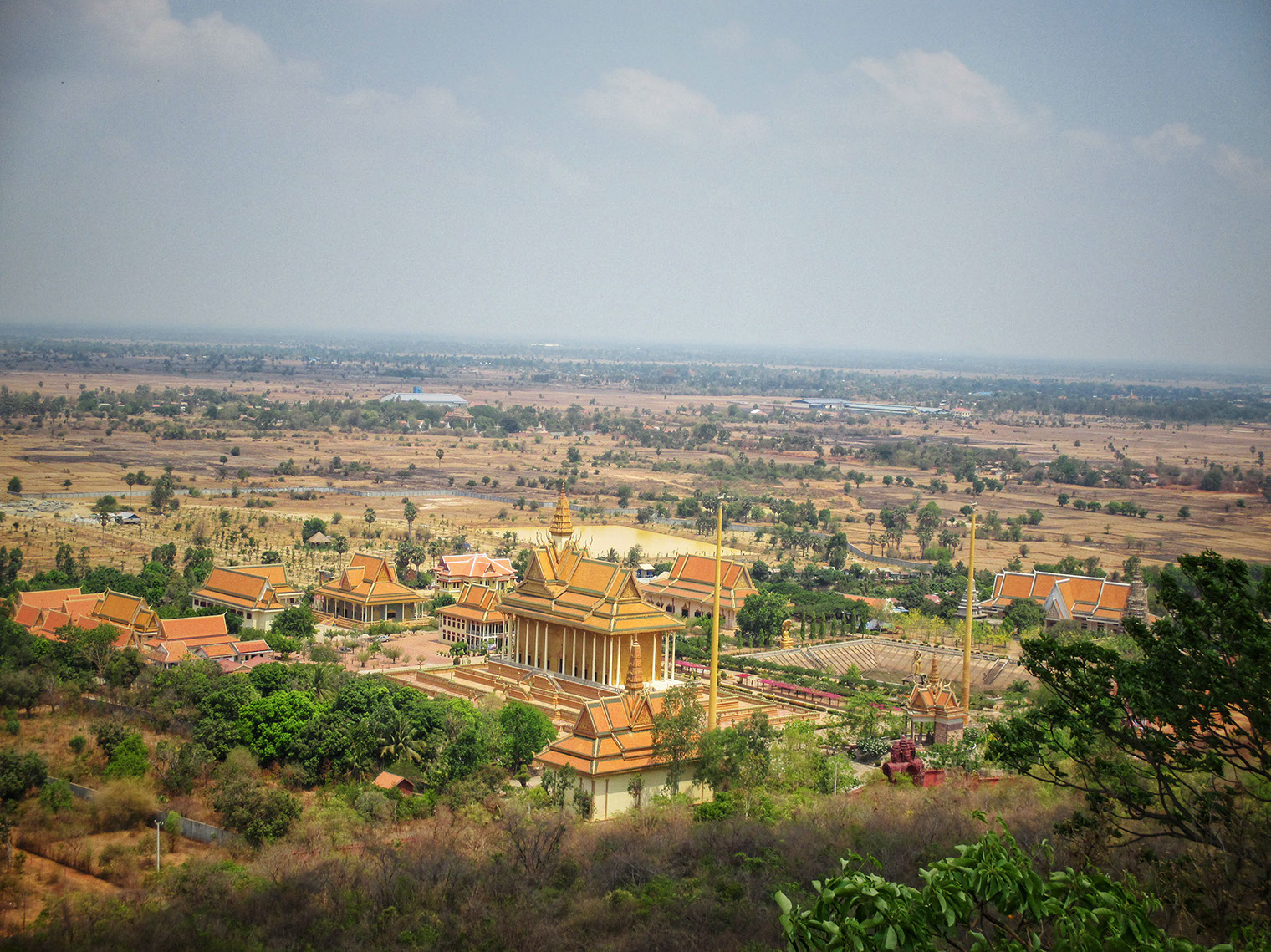
A spectacular view of the Kandal Pagoda from the top of Oudong Mountain
We came across an interesting store along our descent that had an amazing display of locally crafted artifacts like statues and elephant carvings. It was the perfect spot to indulge in souvenir shopping in an attempt to take back memories of this incredible historic place.
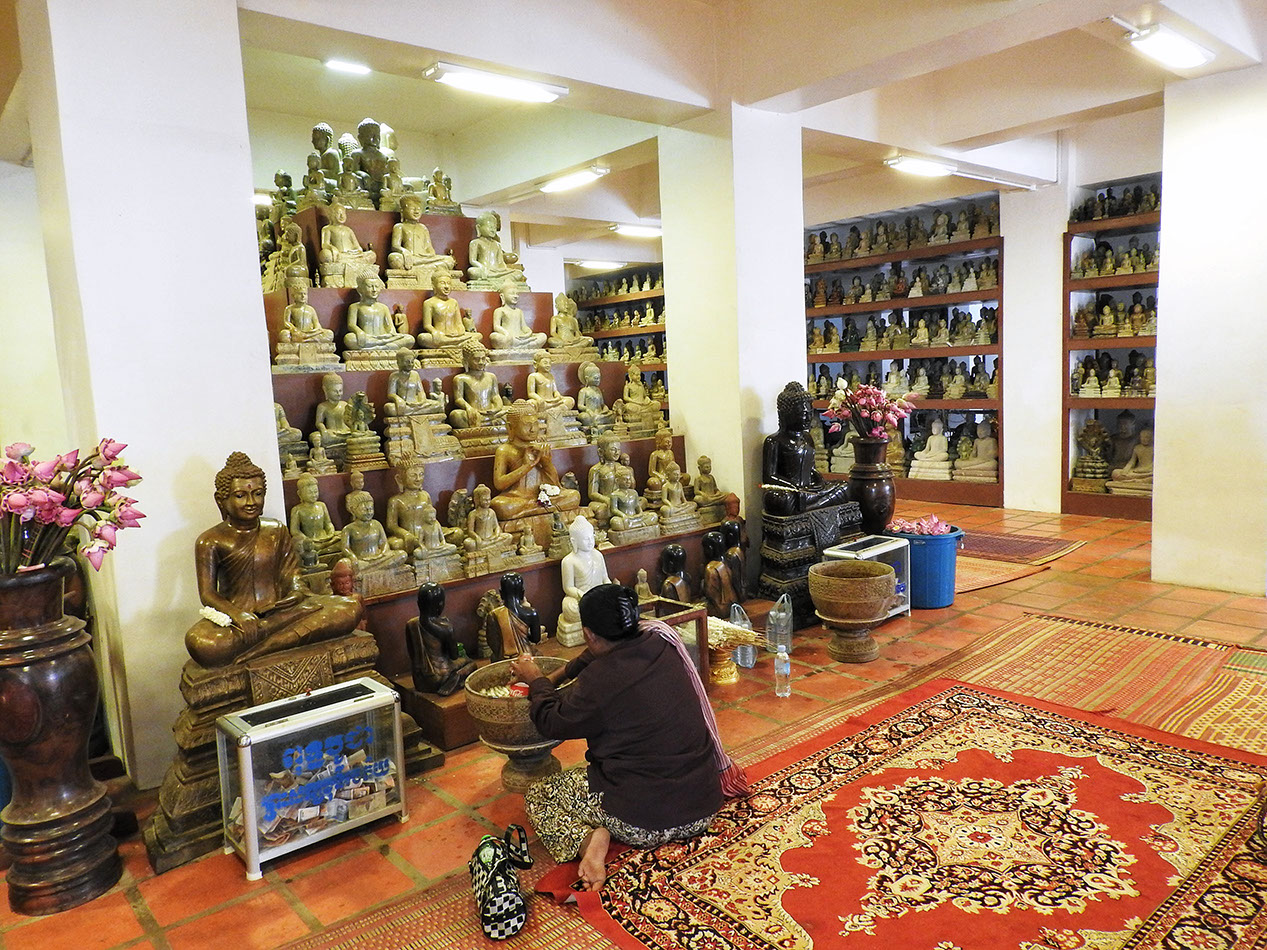
A handicraft stall selling incredible sculptures enroute to the base of the mountain makes for perfect souvenirs
Reaching the base of the mountain, we visited the local market. The ambience is rustic with small stalls selling local handicrafts, food and drinks. We spent some time visiting the stalls and interacting with the locals.
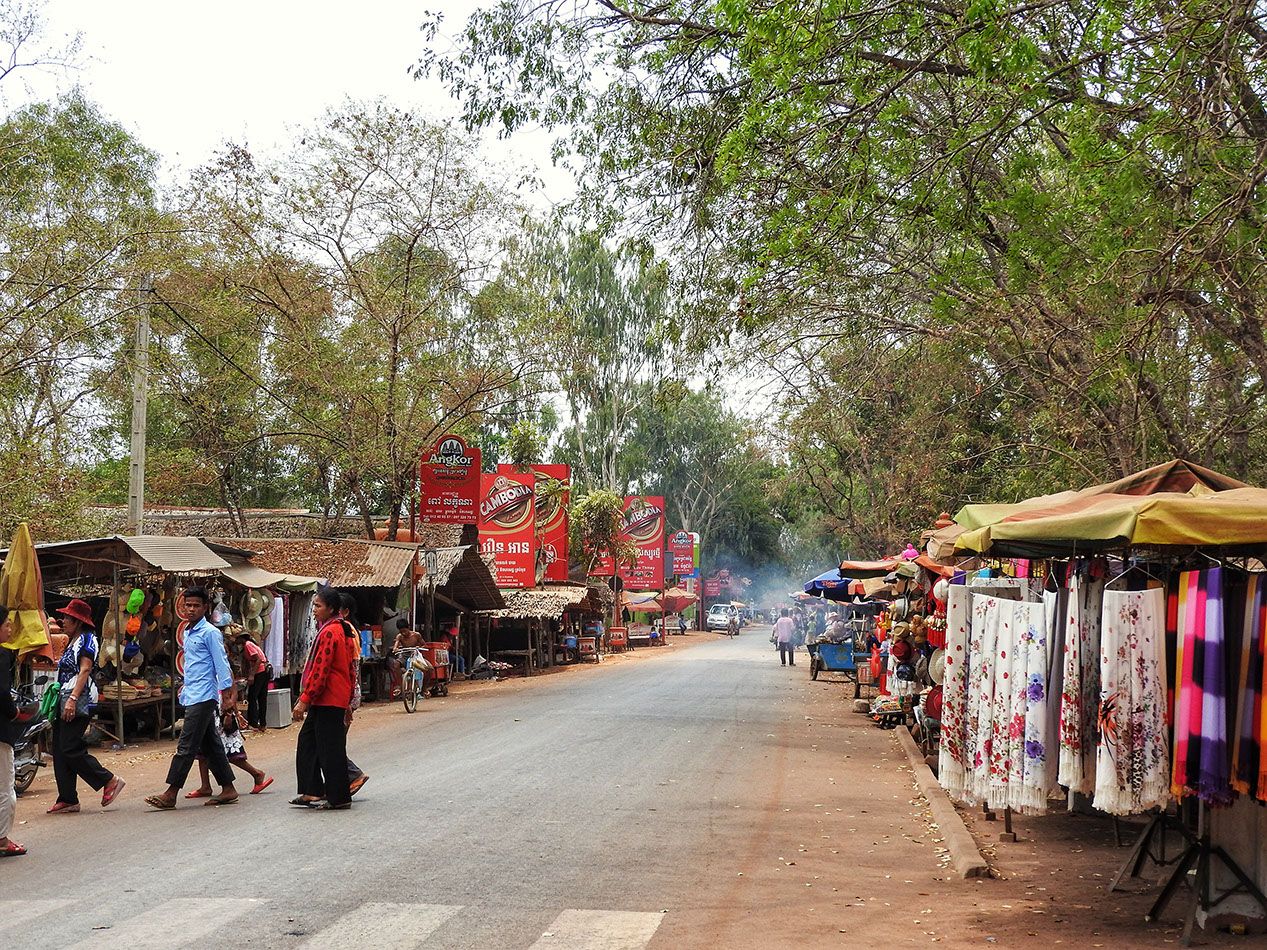
The local market at the base of Oudong Mountain offer an authentic rural experience
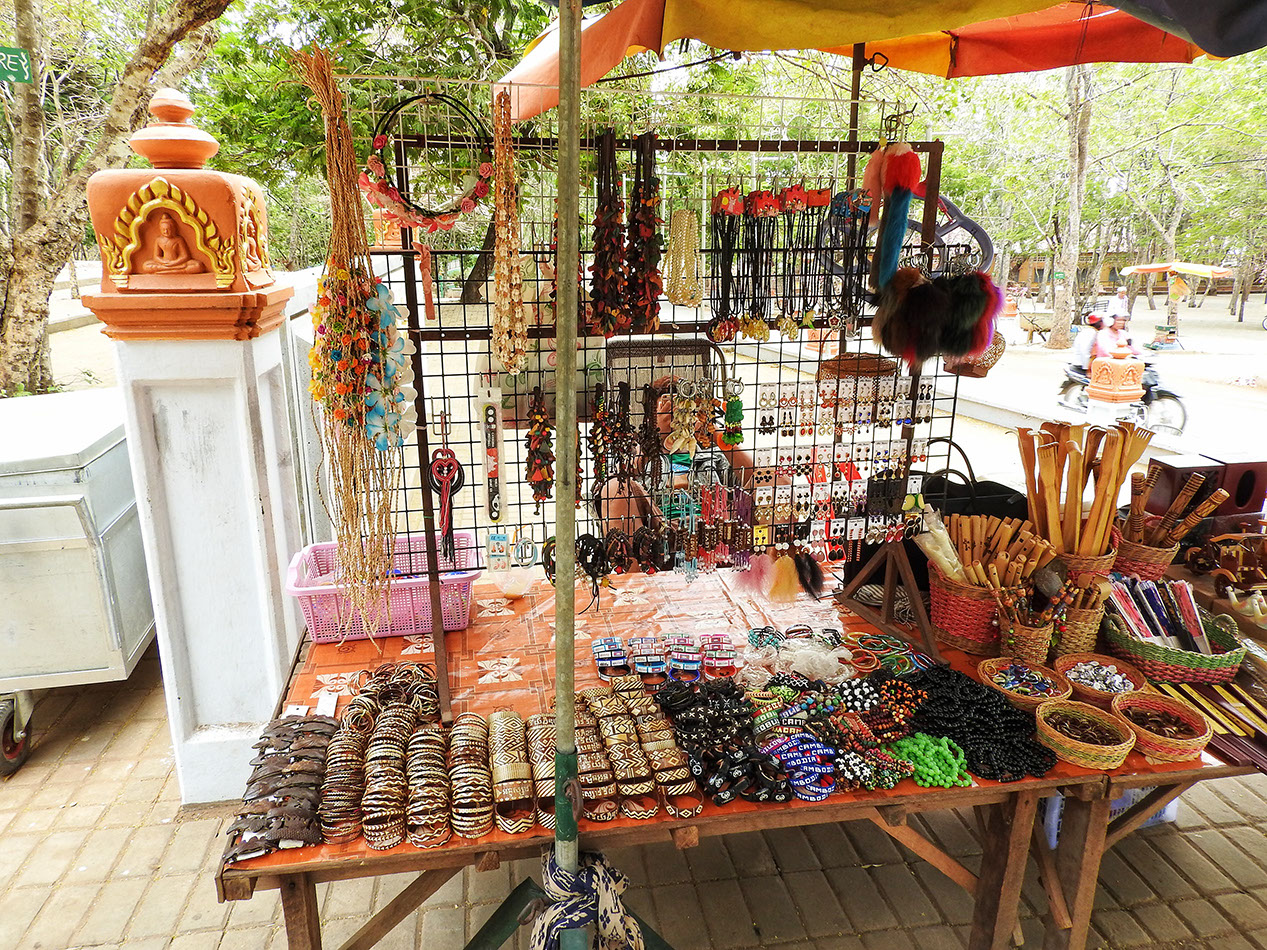
Makeshift stalls selling local handicrafts are a big attraction for tourists
There were several huts surrounded by seating that made for a perfect picnic spot which the locals enjoyed. There were some food stalls selling mostly local Cambodian foods. We did not indulge in any of these "delicacies" as they were largely pork and beef based and as we are vegetarian. We did however enjoy some delicious sugarcane juice and relaxed while immersing ourselves in the local authentic life of Cambodian people.
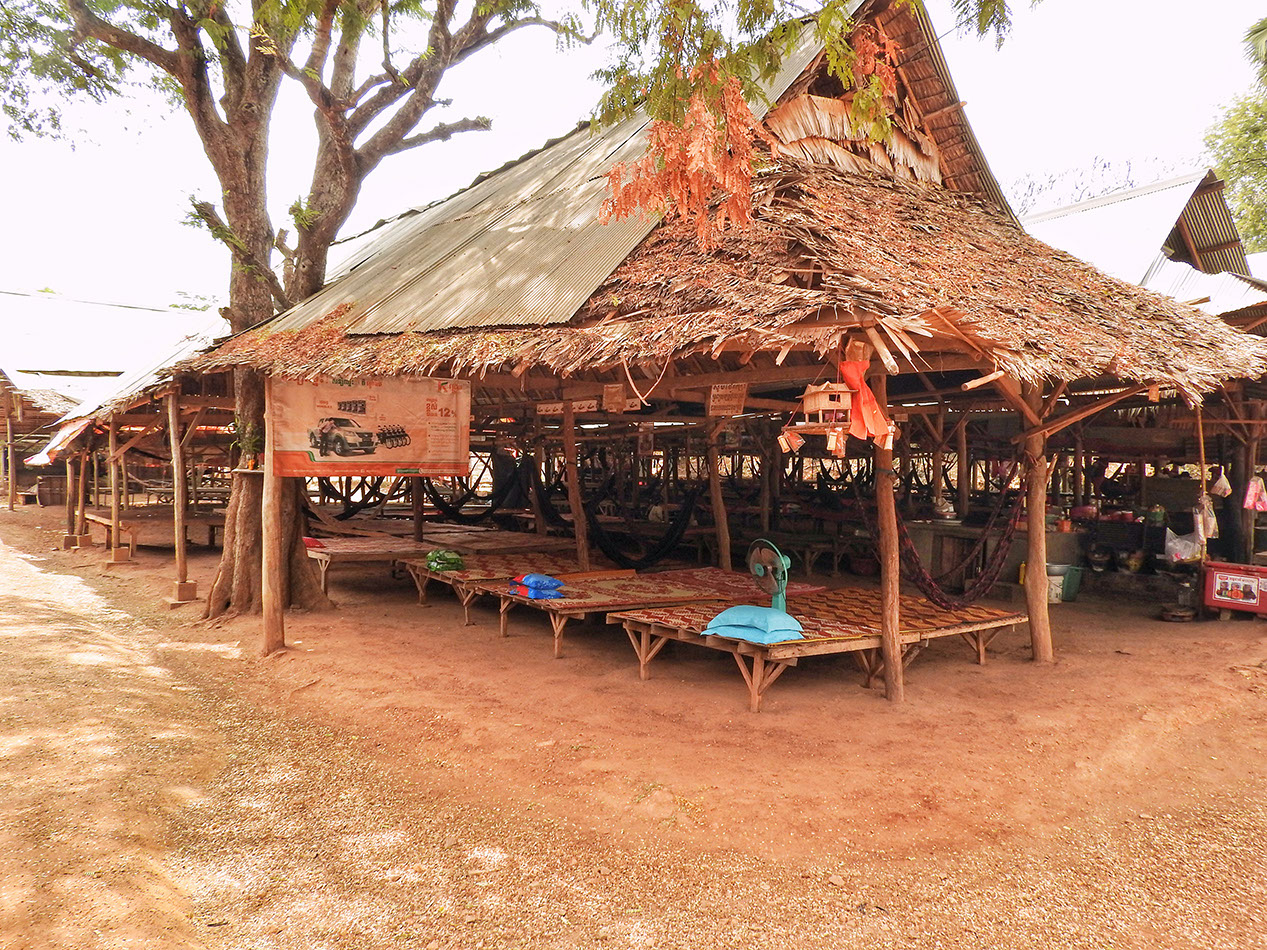
Simple and practical relaxation spots for locals and tourists visiting Oudong Mountain
Oudong is not on the tourist radar because of which the local culture and rural life of Cambodia is evident. A visit to Oudong is worthwhile for those interested in Cambodia's long history and also looking to enjoy scenic attractions in rural settings. What an incredible day it was! We drove back to Phnom Penh in deep conversation about the magnificent archaeological extravaganza we experienced. For those of you seeking an offbeat and rustic experience, Oudong is definitely a MUST VISIT.
What is the best way to see Oudong Mountain?
Oudong Mountain is located in Kampong Speu province, about 40 kilometers northwest of Phnom Penh. The best way to see Oudong Mountain is by hiring a car or tuk-tuk for the day. You can easily find tuk tuks in Phnom Penh who will be willing to take you to Ooudong. Visitors can also hike to the summit of Oudong Mountain, which takes about 2-3 hours round-trip.
Who should visit Oudong?
Oudong is best known for its temples and shrines, which are scattered throughout the town. Many of these temples date back hundreds of years, and are considered to be some of the most important religious sites in Cambodia. As a result, Oudong is a popular destination for pilgrims and tourists alike. Whether you're interested in history, religion, or simply want to enjoy the beauty of nature, Oudong is definitely worth a visit.
What is the best time to visit Oudong?
The best time to visit Oudong is between November and February when the weather is cooler and drier. During this time of year, the mountains are covered in green vegetation and the temples are less crowded. March to May is the hot season in Oudong, while June to October is the wet season.
Who built Oudong?
The city of Oudong was founded in 1601 by King Srei Soriyopear of Cambodia. It served as the country's capital for over 200 years, until it was shifted to Phnom Penh in 1866.
Disclaimer: This blog may contain affiliate links. At no extra cost to you, we may get a small commission if you buy anything. All products and services we endorse have been personally used or come highly recommended to us. These incomes allow us to keep the community supported and ad-free.
Cambodia is equal to "Come With Buddies" in my translation :) , I loved this story and this place is a great place to explore with your friends.

Thank you Mithilesh. Cambodia is surely a place to travel with buddies and that's what I have done many times.
Name
Email
Comment